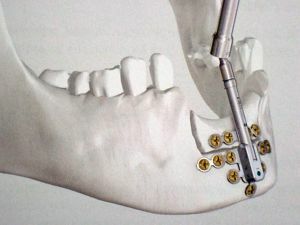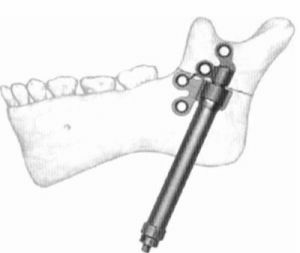 The problem associated with bone tissue growth in dentistry, does not lose its relevance. The fact is that the removal of the tooth leads to the fact that the bone tissue is thinned, that is, its dystrophy occurs.
The problem associated with bone tissue growth in dentistry, does not lose its relevance. The fact is that the removal of the tooth leads to the fact that the bone tissue is thinned, that is, its dystrophy occurs.
If the bone plastic is not produced in a timely manner, it will not be possible to solve the problem of the missing tooth by installing implants. In modern dentistry, special devices are used to restore atrophied bone tissue.
Contents of
- What kind of device is this?
- Objectives of application
- Features of distraction osteogenesis
- Postoperative period
What kind of device is it?
by a distractor I call a device that allows a measurable, gradual, controlled distraction of the craniofacial bones, that is, their stretching and stretching in different directions.
This mechanism is for bone extension. It is used when the jawbone volume is insufficient to install implants, as well as when it is necessary to stimulate bone tissue growth in the vertical direction.
Distraction apparatuses are classified for placement, for use and for the number of exposure vectors. So, depending on the placement, they are extraoral and intraoral.
For the purposes of application, the distractors are intended for the alveolar process, the upper and lower jaw, as well as for the middle zone of the facial area. After the number of vectors, devices can be single-vector and multi-vector.
Objectives of application of
In bone tissue degeneration, bone tissue is thinned, so its restoration is necessary. This problem can arise for various reasons, in particular, for injuries and jaw fractures, after tooth extraction, due to individual anatomical features and inflammatory diseases.
For successful tissue repair, a distractor is used that stimulates the processes of natural bone regeneration. 
The classic procedures of distraction osteogenesis in the maxillofacial area are addressed, if necessary:
- lengthening of the mandibular branches;
- moving the middle part of the face behind LeFort III;
- elongation of the body of the lower jaw;
- jaw extension;
- symphysis widening;
- an increase in the parameters of the alveolar bone;
- movement of the upper jaw beyond LeFort III.
Features of distraction osteogenesis
The procedure starts with the gum that is located above the bone site is opened to expose the site. After that, the integrity of the bone tissue that needs to be stretched is broken by dividing the bone into 2 parts.
Then the distraction device is installed in the resulting gap. Then comes the so-called latent period, in which any forces in the device are not attached.
As mentioned above, a hole is drilled in the jaw, which is necessary to fix the distractor there. In order not to damage the bones by heating, during surgery, boron is cooled by water. When the hole is drilled, the distractor is fixed using small screws. After the bone is restored, all these parts will be completely removed.
After the implantation of the distraction device, it is sutured under the mucous membrane. When the cuts heal, the bone block begins to move with the mucosa upward. At this time they grow up.
In the oral cavity only the screw will be visible, with the help of which a person can independently control the process of distraction.10 days after the implantation of the device, the patient needs to rotate the screw once every day. This should be done until the final correction of the bone defect occurs. During the subsequent implantation, the distractor is removed.

If the operation is successful, the blood supply of the segment that was transported is preserved. The device is correctly positioned, the mucous membrane is provided with sufficient blood supply over the fragment.
Postoperative period
Dental plastic with a distractor has many advantages. So, the time of augmentation, that is, the build-up of the bone, takes place 3-4 months, so this device does not last long.
Full rehabilitation comes after 7 months. In addition, with this procedure, the volume of soft tissues increases, full bones are formed, the wounds heal smoothly, the infection level during the postoperative period is very low. Therefore, antibiotics will not need to be taken in the future.
And the percentage of implant survival is very high. To positive aspects is also the fact that for bone sampling the donor area is not used, after the procedure it is possible to obtain sufficient bone height.
Thus, using a distraction device, bone can be successfully built up. At the same time, the treatment period and rehabilitation period of the patient are reduced, and the number of relapses is minimal.
Among patients who have been operated, full recovery of functions such as speech and mastication is noted, facial signs are harmonized, and this leads to the fact that the emotional state of a person is greatly improved.
